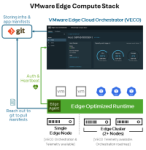Customers worldwide are investing in modern technologies such as AI and machine learning at retail stores, factories and other edge sites to improve efficiency, increase security, lower costs, and delight their customers. Deploying workloads at the edge, close to where data is produced, cuts costs and speeds up decision-making; but deploying and managing infrastructure and applications has typically been reserved for trained IT professionals. The challenge is that IT professionals aren’t typically located at edge sites. Companies are looking for ways to manage devices and infrastructure at these sites without investing in onsite technical personnel or constant truck rolls.
Understanding the lifecycle of edge infrastructure and applications
Staffing challenges at the edge include having the necessary skills to deploy both infrastructure and applications, and manage the lifecycle of both.
- Infrastructure deployment: Edge sites are often very different from traditional IT data centers. They could be industrial or retail locations, or extremely remote locations such as wind turbines or offshore oil platforms. This means that they typically aren’t staffed similar to what is found in the traditional IT data center. The connection and activation of the hardware needs to be a simple process that can be completed by staff that aren’t highly trained IT professionals.
- Application deployment: Edge sites often have unique applications and configurations to support use cases specific to the deployment. This means that the complexity of managing these deployments at scale can be exponentially difficult. A solution is required to simplify the deployment of applications to sites or groups of sites without manual intervention by on-site personnel.
- Patching and lifecycle management: The work of managing infrastructure and applications isn’t complete once it is initially deployed. The threat of security vulnerabilities requires businesses to constantly update their infrastructure and applications to avoid business-impacting threats or failures. Modern applications built using DevOps methodologies need to implement frequent updates when dealing with a large number of sites. Thus, it becomes increasingly important to have an automated and centralized process to keep applications and infrastructure up to date.
Overcoming challenges of having limited IT personnel to deliver edge-native applications
VMware Edge Compute Stack is a purpose-built, integrated virtual machine and container-based platform that enables organizations to modernize and secure edge-native apps at the far edge, paving the way to support edge AI applications and infrastructure. The platform simplifies management of hundreds or thousands of edge locations without trained technical staff on site. Its features include zero-touch provisioning and lifecycle management of apps and infrastructure, desired-state configuration, and built-in security measures that address the potential lack of physical security at edge locations.
Let’s learn how VMware Edge Compute Stack helps simplify edge provisioning and support so you can focus on your business goals:
- Zero-touch provisioning at edge sites: Installing and configuring servers is typically a task for trained IT professionals. Edge sites such as retail locations and power substations rarely have IT staff on site that are trained in deploying and managing servers. Zero-touch provisioning of hardware and deployment of applications with VMware Edge Compute Stack allows the trained IT staff to remotely activate and configure the hardware and deploy the necessary applications after the hardware is connected to power and network. This allows businesses to reduce the high cost of staffing trained IT professionals for all edge locations. Once the initial host image is installed, the hardware can be shipped to the location. Once powered on and connected to the network, it will authenticate with VMware Edge Cloud Orchestrator to activate and synchronize with a desired-state configuration. When the infrastructure software or applications need to be updated, the desired-state configuration can be updated by remote IT staff, which will kick off an update to the appropriate edge sites.
- Desired-state configuration: The use of Flux and desired-state configuration files in VMware Edge Compute Stack simplifies the deployment of infrastructure constructs (virtual machines and Kubernetes clusters) along with applications. Remote IT staff can define the necessary infrastructure and applications necessary for a site or group of sites and VMware Edge Compute Stack will automatically deploy and configure the site remotely without the need for trained IT staff at each location. The approach of using the desired-state configuration also prevents the need to develop custom automation workflows to deploy each new application or configuration that a business needs.
- Patching/upgrades: The combination of desired-state configuration files and customer-defined image repositories in VMware Edge Compute Stack also makes it simple for businesses to keep their edge infrastructure and applications up to date, protecting them from bugs and security vulnerabilities. The customer can update the application images or desired-state configuration to automatically trigger the upgrades and patching at each site. This ability will help businesses avoid the potential financial and reputational impacts that can be caused by application failures or hacks.
Conclusion
In addition to the other benefits discussed in our first post, VMware Edge Compute Stack addresses the limitation of trained IT personnel availability at the edge in multiple ways:
- Zero-touch provisioning allows the edge infrastructure to be activated and configured automatically after it is powered up and establishes network connectivity.
- Applications can be deployed remotely using desired-state configuration files and application images in a customer-defined repository.
- Both infrastructure constructs (virtual machines and Kubernetes clusters) and applications can be deployed using these desired-state configurations.
- Updates to the desired-state configurations in the customer’s repository can trigger necessary updates and patches to edge deployments.
Try it for free
- Try VMware Edge Compute Stack for free at support.broadcom.com/group/ecx/trials-program
- Questions? Email us at sde-edgecomputestack.pdl@broadcom.com
Learn more
This blog is part of a series exploring the real challenges of deploying and managing applications at the edge, and how VMware Edge Compute Stack helps companies overcome those obstacles to meet their business goals.







